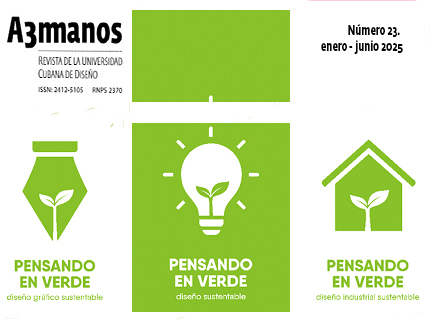Artificial Intelligence in Design
##plugins.themes.bootstrap3.article.main##
Abstract
The emergence of artificial intelligence in design processes has been transformative and it has changed the mode products are created. This paper explores how artificial intelligence impacts the design industry and it identifies tools and applications developed using artificial intelligence techniques that can be used in the design process. Although the use of artificial intelligence in design arise doubts, fears and ethical dilemmas, it is possible to establish a creative collaboration between designers and artificial intelligence tools to optimize tasks in the design process.
##plugins.themes.bootstrap3.article.details##
As of Volume 11, Issue. 21, corresponding to the year 2024, this CC BY-NC 4.0 license replaces the one used in previous issues, namely CC BY-NC-SA 4.0

This work is licensed under a Creative Commons Attribution-NonCommercial 4.0 International License.
- Attribution ā You must give appropriate credit , provide a link to the license, and indicate if changes were made . You may do so in any reasonable manner, but not in any way that suggests the licensor endorses you or your use.
- NonCommercial ā You may not use the material for commercial purposes .
- No additional restrictions ā You may not apply legal terms or technological measures that legally restrict others from doing anything the license permits.
- ShareAlike ā If you remix, transform, or build upon the material, you must distribute your contribution under the same license as the original. NOTE: This point applies to numbers 1 to 20 of the magazine with the previous CC-BY-NC-SA 4.0 license. Does not apply to the new CC BY-NC 4.0 license from Volume 11, Number. 21 (2024).
References
Ali Elfa, M. A. y Dawood, M. E. T. (2023). Using Artificial Intelligence for enhancing Human Creativity. Journal of Art, Design and Music, 2(2). https://doi.org/10.55554/2785-9649.1017
Aswal, P. (2022, septiembre 13). AI Revolution In Design. Indian Institute of Art & Design. https://www.iiad.edu.in/the-circle/ai-revolution-in-design/
Barr, A. y Feigenbaum, E. (1981). The Handbook of Artificial Intelligence (Vol. 1). William Kaufmann, Inc.
Cui, Y. R., Liu, Q., Gao, C. Y. y Su, Z. (2018). FashionGAN: Display your fashion design using Conditional Generative Adversarial Nets. Computer Graphics Forum, 37(7), 109-119. https://doi.org/10.1111/cgf.13552
Figoli, F. A., Mattioli, F. y Rampino, L. (2022). Artificial intelligence in the design process. The Impact on Creativity and Team Collaboration. FrancoAngeli Open Access.
Kazi, R. H., Grossman, T., Cheong, H., Hashemi, A. y Fitzmaurice, G. (2017). DreamSketch: Early Stage 3D Design Explorations with Sketching and Generative Design. Proceedings of the 30th Annual ACM Symposium on User Interface Software and Technology, 401-414. https://doi.org/10.1145/3126594.3126662
Khroma. (2023). KhromaāThe AI color tool for designers. https://khroma.co
Kurz, K. (2017, junio). Adobe Sensei Overview. https://partnerdownload.adobe.com/p/AdobeSensei_overview_Klaus_Kurz.pdf
Lavigne, R. (2024, enero 19). Comparing DALL-E, Stable Diffusion, and Midjourney Prompt Engineering (2024). Medium. https://medium.com/@RLavigne42/comparing-dall-e-stable-diffusion-and-midjourney-prompt-engineering-2024-4bf19ac11256
Maggs, P. (2023, octubre 31). The Future of Artificial Intelligence (AI) in Design. Superside. https://www.superside.com/blog/ai-in-design
Maslej, N., Fattorini, L., Brynjolfsson, E., Etchemendy, J., Ligett, K., Lyons, T., Manyik, J., Ngo, H., Niebles, J. C., Parli, V., Shoham, Y., Wald, R., Clark, J. y Perrault, R. (2023). The AI Index 2023 Annual Report. AI Index Steering Committee, Institute for Human-Centered AI, Stanford University.
Mattey, W. (2024, marzo 29). 12 Cutting-Edge AI Tools Every Web Designer Needs to Know [LinkedIn]. The Creative Compass Weekly. https://www.linkedin.com/pulse/12-cutting-edge-ai-tools-every-web-designer-needs-know-william-mattey-wy54f/
McCulloch, W. S. y Pitts, W. (1943). A logical calculus of the ideas immanent in nervous activity. The Bulletin of Mathematical Biophysics, 5(4), 115-133. https://doi.org/10.1007/BF02478259
Midjourney. (s. f.). Midjourney. Recuperado 11 de junio de 2024, de https://www.midjourney.com/website
Mohamad Diab, Julian Herrera, Musical Sleep, Bob Chernow, y Coco Mao. (2022). Stable Diffusion Prompt Book. OpenArt. https://openart.ai/promptbook
Nagamachi, M. (1995). Kansei Engineering: A new ergonomic consumer-oriented technology for product development. International Journal of Industrial Ergonomics, 15(1), 3-11. https://doi.org/10.1016/0169-8141(94)00052-5
OpenAI. (2021). DALLĀ·E: Creating images from text. https://openai.com/index/dall-e/
OpenAI. (2022). DALLĀ·E 2. https://openai.com/index/dall-e-2/
OpenAI. (2023). DALLĀ·E 3. https://openai.com/index/dall-e-3/
Philips, M. (2018). The Present and Future of AI in Design (With Infographic). Toptal.com. https://www.toptal.com/designers/product-design/infographic-ai-in-design&t=The%20Present%20and%20Future%20of%20AI%20in%20Design%20(with%20infographic)
Pivoted Pixel. (2023, mayo 4). Impact of AI on Graphic Design: Better Than Human? https://pivotedpixel.com/graphic-design/impact-of-ai-on-graphic-design/
Planner 5D. (2024, junio 7). Inteligencia Artificial para DiseƱo de Interiores. https://planner5d.com/es/use/ia-interiores
Quan, H., Li, S. y Hu, J. (2018). Product Innovation Design Based on Deep Learning and Kansei Engineering. Applied Sciences, 8(12), Article 12. https://doi.org/10.3390/app8122397
Reyes, A. (2020, diciembre 18). Why Machine Learning is not Artificial Intelligence? Medium. https://oilgains.medium.com/why-machine-learning-is-not-artificial-intelligence-61b174a3c9a2
Rich, E. y Knight, K. (1991). Artificial Intelligence (2.a ed.). McGraw-Hill.
Rumelhart, D. E., Hinton, G. E. y Williams, R. J. (1986). Learning representations by back-propagating errors. Nature, 323(6088), 533-536. https://doi.org/10.1038/323533a0
Russell, S. y Norvig, P. (2004). Inteligencia Artificial. Un enfoque moderno (2.a ed.). Pearson EducaciĆ³n, S.A.
Schmitt, P. (2019). The Chair Project (Four Classics). Philipp Schmitt. https://philippschmitt.com/work/chair
Shannon, C. E. (1950). A Chess-Playing Machine. Scientific American, 182(2), 48-51.
Singh, R. (2024, febrero 16). 10 Best Latest AI-Powered Tools for Designers 2024. Web Designer Hub. https://www.webdesignerhub.org/ai-tools-for-designers/
The AI Digital Quill. (2024, enero 30). Comparative Analysis between DALLĀ·E, Stability AI, and Midjourney. Medium. https://medium.com/@DigitalQuill.ai/comparative-analysis-dall-e-stability-ai-midjourney-ai-art-stable-diffusion-image-generation-72dc58669b6c
Turing, A. M. (1950). Computing Machinery and Intelligence. Mind, 59(October), 433-460. https://doi.org/10.1093/mind/lix.236.433
Vizcom. (s. f.). Vizcom. Recuperado 7 de junio de 2024, de https://www.vizcom.ai/
























